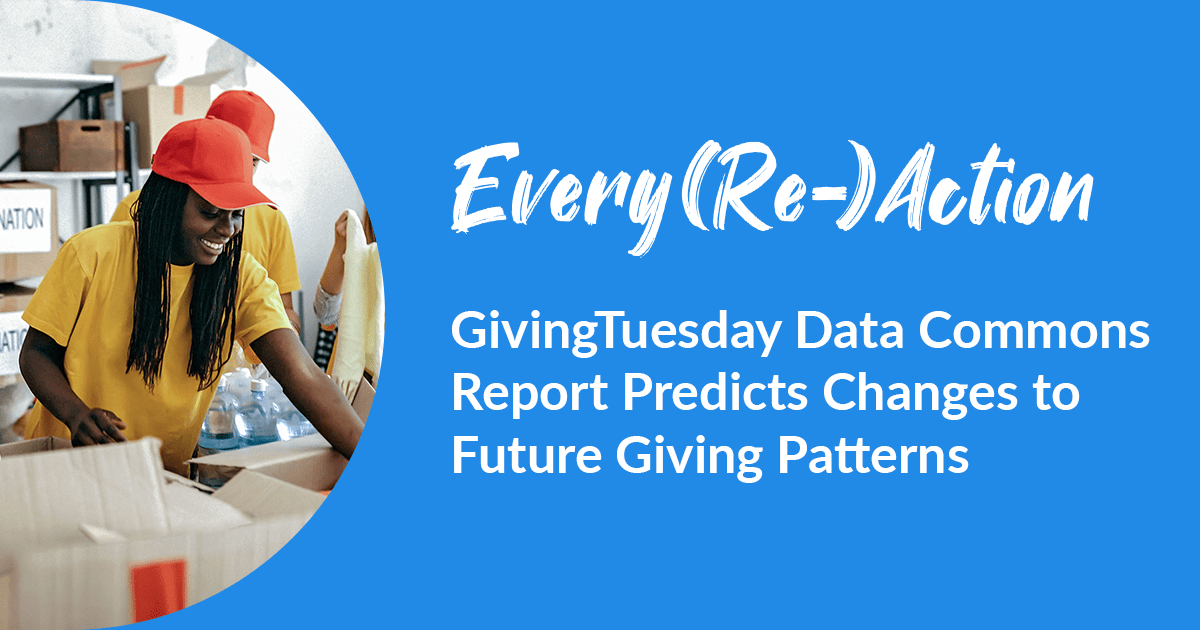Every(Re)Action | GivingTuesday Data Commons Report Predicts Changes to Future Giving Patterns

GivingTuesday, the organization behind one of the biggest single-day giving events in the United States and across the world, has released a report on 2020 giving and 2021 trends through the GivingTuesday Data Commons. The report “primarily focuses on one facet of generosity: monetary giving to [small-to-medium 501(c)(3)] nonprofit organizations [with no more than $25M in contributions.]”
While the report’s headlines show increased giving overall, they point out that 2020 giving didn’t increase equally across all nonprofit organizations or issue areas—and they also predict changing trends in charitable giving as current crises evolve and subside.
Although the report’s findings are concentrated on monetary giving, the authors recognize the complexity of the moment in their introduction:
Where systems [in 2020] were overwhelmed or unable to meet the demand, neighbors, families, friends and strangers stepped in to weave together their own safety nets through giving circles, mutual aid networks, community fridges, and other acts rooted in reciprocity and mutuality that exist beyond a formalized social sector. While financial support for nonprofits is an important component of support and enrichment for communities, we aim to explore this full landscape of generosity and how it shapes the way we think about community in subsequent reports and research.
Key Findings
The GivingTuesday Data Commons report’s key findings include:
Donor mobility increased more than ever before, particularly in small donations. With a year of marked overall donation growth, we expect to see all metrics increase, but donor retention continued to drop while donor acquisition surged, particularly for donors giving small amounts. This was likely due to increased shifts in where and when donors gave last year, with more donors giving to pandemic-related causes. 2020 was also unique in that it bucked the multi-year trend of fewer donors giving.
Cause area winners and losers followed societal challenges. While total giving was up, some cause areas saw significant gains, while others suffered lost revenue. Health and Human Services showed the most growth, which mirrored the increased demand for services due to COVID-19 and the groundswell of response in pursuit of racial justice. Arts and Culture showed clear declines, reflecting lost access due to stay-at-home orders, social distancing, and reduced event-based fundraising opportunities.
Widening inequality affects smaller revenue nonprofits, not just lower wealth individuals. Even in cause areas that experienced increased giving in 2020, most of that giving focused on organizations with the greatest fundraising totals. The typical nonprofit experienced much lower results during 2020. We also saw a dramatic increase in the percentage of nonprofits that did not fundraise each month, particularly for smaller nonprofits.
Predictions for 2021
From these key findings, the GivingTuesday Data Commons made the following predictions for 2021:
Charitable giving patterns will return to pre-2020 trends. We expect fewer and weaker giving moments to drive fundraising. We anticipate this may result in a decrease in YOY revenue, huge retention drops for human services, and a spike in recapture rates for other causes.
Smaller organizations will appear to do better in 2021. Organizations that saw a drop in annual revenue, but remained solvent, will rebound.
Small repeat/recurring donations will be an important tactic to upgrade donors. However, prevalence of repeat donations will stagnate as there may be fewer giving moments that lead to fewer concrete reasons for donors to activate within a year.
We have to agree about the importance of repeat donations in particular—we’re longtime advocates for creating a strong sustainer program, since recurring donors’ reliable revenue and greater donor lifetime values make them incredibly helpful to nonprofits who want to create long-lasting relationships with their supporters and raise more for their mission.
Recommendations for 2021
From their 2020 findings and 2021 predictions, the GivingTuesday Data Commons’ recommendations for nonprofits’ fundraising strategies moving forward included these three key initiatives:
Create and share giving moments. Highlight events that reinforce the urge to give. Shared moments, such as giving days, crisis response, holidays, awareness days, and community events, tap into a sense of community and urgency that inspire increased giving of all types.
Don’t shy away from engaging givers, especially in tough times. We know that, even when fundraising is dramatically down and presents a lower return on investment during hard times, organizations that continue to engage givers regularly and diversify what and how they ask are more likely to reap outsized rewards when economic, health, and social crises subside.
Increase focus on recaptured donors and mid-size donors. As fundraising returns to pre-2020 levels, there will be a larger-than-ever pool of recently lapsed (and likely highly engaged) donors. Look for ways to steward and engage them while also re-engaging mid-size donors who stagnated in 2020.
Our Take
2020 was a watershed year for giving, and a fascinating one for charitable donation reporting — there’s certainly no shortage of data analysis. However, we think nonprofits should remember these three unique takeaways from the GivingTuesday Data Commons report:
- Giving Days continue to hold meaningful fundraising power. Our friends at GiveGab say, “Giving Days grow donations 10X faster than any other giving channel and retain donors 3x more according to Giving USA. Repeat GiveGab Giving Day partners have seen an average growth of 40% year over year.”
- Giving Days, like GivingTuesday, encompass more than just fundraising. If you’re looking to maximize the impact of your one-day-only volunteer effort, you’ll need to tap into your audience and their own unique networks—because our friends at Mobilize found that network effect can help you increase sign-ups and decrease no-shows (by up to 30 percent!)
- What happens before and after a Giving Day matters. Building relationships with your audiences, encouraging them to join your sustainer program, predicting your donors’ ability to give, and taking other actions are what will drive long-term support for your mission.


